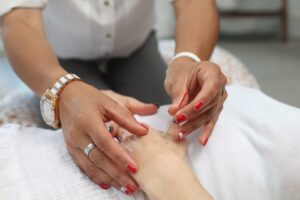Subscribe to the Newsletter
If you are interested in understanding how Traditional Chinese Medicine can improve your life sign up to my newsletter for the latest updates.
Wiguan, Three Heater 5, is the fifth point on the Three Heater acupuncture channel.
On the posterior surface of the forearm, between the radius and the ulna bones 2 cun proximal to the wrist flexure, on the radial side of the extensor digitorum communis tendon.
Insert either slightly obliquely distally or proximally, or laterally towards the ulna bone. Depth up to 1.5 cun. Can needle it through to Neiguan, Pericardium 6.
Strong local gripping sensation which may extend towards the fingers.
Moxibustion: Up to 3x.
These actions are part of Chinese medicine theory.
Possibly better for Wind-Heat than for Wind-Cold, as in febrile diseases. However, can be used with Large Intestine 4 for Wind-Cold.
For appropriate syndromes or for areas reached by this channel or the Gallbladder channel:

Waiguan, Three Heater 5, was a popular point in the hospital clinic when I trained in China. We had many very vigorous manual workers who got caught by intense cold weather.
The syndromes they developed usually responded well to this point.
Although its name, ‘Outer Frontier Gate’ shows that its main properties concern attack by exterior disease, I have also used it for strong internal Wind syndromes, together with other points dealing with the interior deficiency.
I don’t usually use it alone. Other points, often local, ‘direct’ its Qi.
Three Heater 5 does so much that sometimes it seems no other point on the channel is needed: but they are, very much.
To understand better its action, click on Three Heater luo channel.

Stay in Touch!
No spam, only notifications about new articles and updates.

Book a Video consultation if you want to know more about your symptoms

This Introductory Chinese medicine course introduces you to the amazing thinking behind this ancient medicine, now increasingly in demand.

The Scottish College for Chinese medicine provides introductory courses for all, explaining Chinese medicine and its cultural background.

Master Tung’s acupuncture is a hidden treasure, lost to China but recovered in Taiwan from where it spread round the world.

Knee pain has five main causes. It’s certainly worth trying acupuncture before you resort to surgery!
Subscribe to the Newsletter
If you are interested in understanding how Traditional Chinese Medicine can improve your life sign up to my newsletter for the latest updates.
Subscribe to the Newsletter
If you are interested in understanding how Traditional Chinese Medicine can improve your life sign up to my newsletter for the latest updates.
2 Responses
Hi Jonathan, I’m Thomas from Argentina. I’m a beginner TCM student and most of the times I find Wai Guan and Nei aguan hard to needle, and it hurts. Could I be doing something wrong? I’m a 37 years old athlete with muscular development, which leads me to think it could get more difficult needling people like me.
Thanks a lot
Hi Ezequiel, Thanks for your enquiry. Yes, these points can be sore, though more sore for Neiguan than Waiguan in my experience. With Neiguan, one problem is the presence of the median nerve right under where you insert the needle. If you do touch this nerve, and get a tingling numbing sensation usually down towards the palm, don’t manipulate the needle any more: the presence of the sensation means you have indeed ‘hit’ the point.
However, what I do is warn the patient about this and if, when, they get the tingling, I raise the needle and aim to either side of where I was aiming before, thereby avoiding the nerve. So once through the skin, insert very slowly and cautiously. (I assume you’re ok about finding the point in the first place, 2 cun proximal to the wrist and between the tendons?) Of course you may also change the direction of the needle proximally or distally depending on whether you are using the point for chest, elbow or wrist conditions.
For waiguan, the problem is not so much insertion as finding the insertion point in the first place. Again, the point lies 2 cun proximal to Yangchi TB4, but it’s not in the middle. It’s on the radial side, often quite close to the radius bone. Having found the insertion point, direct the needle slightly obliquely towards the ulnar side (or of course proximally or distally depending on intention, as above).
Again insert cautiously. With waiguan you are less likely to touch the nerve unless you go too deep. But you can often do through-and-through needling to connect with neiguan which lies inferior to the nerve.
Hope this helps. Jonathan